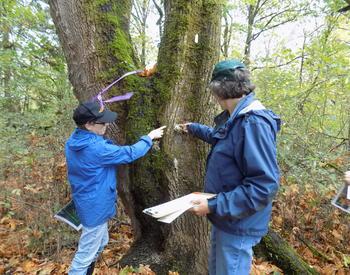Treatments for bronze birch borer?
I had an arborist out because one of my birch trees had died and needed removal. He said it was the bronze birch beetle and that it was beginning to affect a second birch. He said it could be treated with a substance that I could pour on the ground around the tree and it would drink it up and poison the beetles. What product should I use and will I be able to save my tree?
Bronze birch borer has been a major problem for birches in the Willamette Valley and Southern Oregon. Damage from storms, along with summer heat and drought, make birches even more vulnerable.
Susceptibility to bronze birch borer
With regard to saving your birch tree with an insecticide soil drench, success with this method depends on which species of birch you have and how much damage and decline has already occurred. Seriously damaged/declining trees do not have enough vigor to take up insecticides such as imidacloprid that are used in a soil drench treatment.
More information on assessing the damage of your birch tree can be found in OSU Extension's recently revised publication Homeowner Guide to Managing Bronze Birch Borer.
In many cases in the Willamette Valley area, in spite of any treatments to save the trees, the long-term outcome for the more vulnerable birch species is replacement with other tree species.
Susceptible birch species:
- Jacquemontii birch
- Whitebarked Himalayan birch (Betula jacquemontii)
- European white birch, silver birch (B. pendula)
- European white weeping birch
- Young's weeping birch (B. pendula 'Youngii')
- Ornamental cutleaf varieties of birch
Moderately susceptible birch species:
- Gray birch (B. populifolia)
- Whitespire birch (B. platyphylla japonica 'Whitespire')
- Yellow birch (B. alleghaniensis)
- Sweet birch
- Black birch
- Cherry birch (B. lenta)
- Paper birch
- White birch
- Canoe birch (B. papyrifer).
You can learn more about bronze birch borer and which species are least susceptible in the PNW Insect Management handbook's page on Bronze birch borer.
Chemical control of bronze birch borer
See table 4 in Chemical Control of Landscape Pests from the PNW Pest Management Handbook. Under "wood or trunk borers", it lists bronze birch borer and shows systemic chemicals that could be applicable for soil drench. Look for products with those ingredients online or at a farm/garden supplier and follow the directions for application.
Note also that beneficial insects such as pollinators are susceptible to these pesticides and care should be taken to avoid exposing beneficial insects.
¡Use los pesticidas con seguridad!
- Póngase ropa de protección y equipo de seguridad según las recomendaciones de la etiqueta. Báñese después de cada uso.
- Lea la etiqueta del pesticida—aunque lo haya usado antes. Siga al pie de la letra las indicaciones de la etiqueta (y cualquiera otra indicación que Ud. tenga).
- Tenga precaución al aplicar los pesticidas. Conozca su responsabilidad legal como aplicador de pesticidas. Usted puede ser responsable de heridas o daños resultantes del uso de un pesticida.

 Extension Service
Extension Service